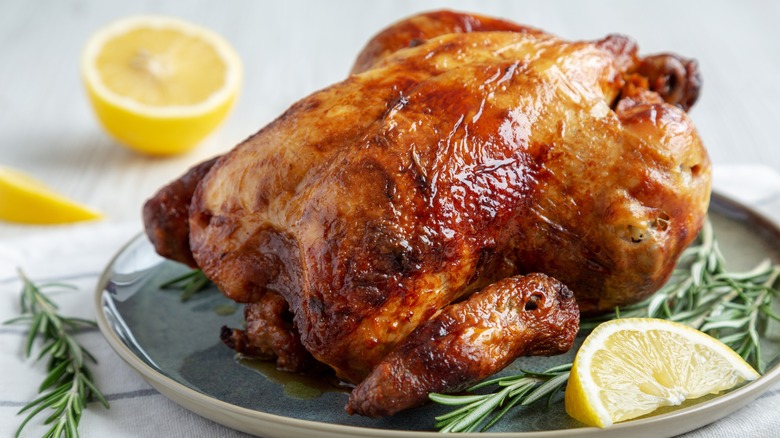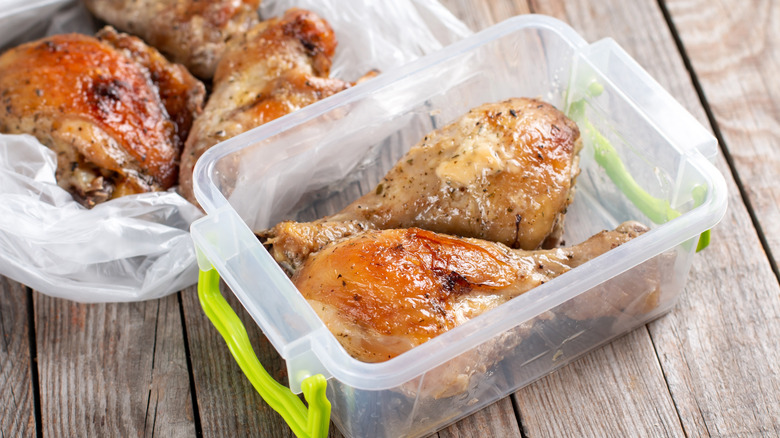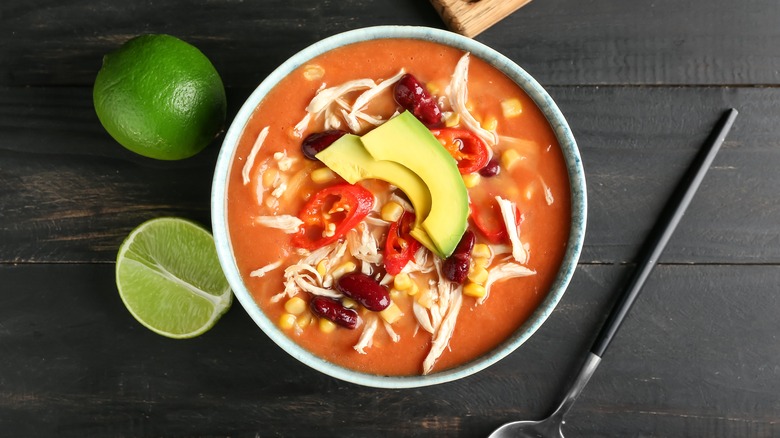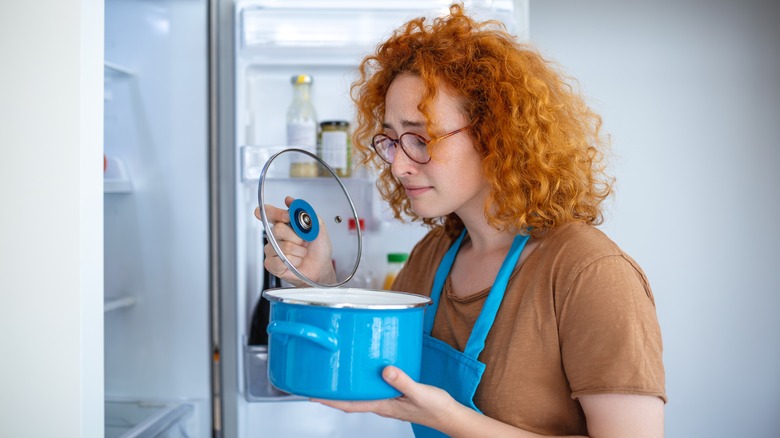How Long A Rotisserie Chicken Will Last In The Fridge
There's no denying that rotisserie chicken is one of the most cost-effective food items available at grocery stores. Its delectable flavors and relatively low price tag make it a favorite among home cooks, but its large size inevitably leads many to ask just how long any leftovers are safe to eat. Unfortunately, the answer to that question is not longer than a week.
According to the U.S. Department of Agriculture, a rotisserie chicken will last up to four days in a fridge set at or below 40 degrees Fahrenheit. The exact time your chicken takes to spoil can vary depending on how long it sat out on the heating display, and whether it was warm enough to prevent pathogens from spreading, so try to pick the freshest bird at the grocery store.
You should also consider how long your cooked chicken has been left out at room temperature. Any longer than two hours puts you at risk of food poisoning, so try to store any leftovers as soon as possible to avoid forgetting about them. The time frame to eat or store your rotisserie chicken also gets cut down to 60 minutes if the weather's above 90 degrees Fahrenheit, so keep that in mind if you're commuting a considerable distance to get your bird.
Use an airtight container to store rotisserie chicken
When you walk through the rotisserie aisle at a grocery store, you're likely to encounter the savory smells of roast chicken. While undoubtedly a pleasant experience, this should also be a good indicator that the container your bird currently sits in is not airtight. Don't use porous items to store leftovers; instead, transfer any extras to a different container or bag.
Most airtight containers found in a typical home cook's kitchen are not the size of a whole bird, so you'll likely need to either carve or debone your chicken beforehand. While this might seem like a hassle, it actually provides a lot of control over how you want it stored. You can keep the breast, wings, and legs intact, or choose to shred everything at once. Any leftover bones and juices should be stored in their own container as well, as they can be used later to make stock or gravy.
Don't be quick to discard your rotisserie's original packaging if it's a bag. It can be used as a method to quickly debone the chicken, helping you avoid unnecessarily dirtying your fingers and kitchenware. However, feel free to dispose of those flimsy plastic trays in the trash, as they are typically not recyclable.
Yes, you can freeze rotisserie chicken
If you're having trouble using all your rotisserie chicken within four days, it's a great idea to freeze it. Technically, the freezer can preserve your leftovers indefinitely, but after four months quality may start to degrade (per USDA). You can freeze a whole rotisserie chicken, shred the meat, or break it up into parts (drumsticks, wings, breasts). Portioning makes it easier to use only as much as you need for recipes.
You'll want to fully cool hot chicken before freezing, as putting heated foods into the freezer can cause a temperature drop and encourage bacterial growth. To freeze, wrap the chicken in plastic wrap or aluminum foil (this helps prevent freezer burn) and store in an air-tight container or freezer safe zip-top bag.
There are correct ways to thaw frozen chicken but leaving it out on the counter is not one of them. You can place your chicken in the refrigerator where whole chickens or larger pieces can take from one to two days to thaw — shredded will defrost faster. You can also thaw chicken under cold water by submerging it in a leak-proof container or bag. The water should be changed every half hour to keep it cold, and you can expect a whole chicken or its pieces to thaw within a few hours. To reheat rotisserie chicken to keep the skin nice and crispy, use your oven to heat the chicken to an internal temperature of at least 165 degrees Fahrenheit.
What to make with leftover rotisserie chicken
One key tip when shopping is to buy the heaviest rotisserie chicken because they are the most tender and juicy. If this trick leads you to leftovers, there are numerous delicious ways to repurpose them. Casseroles, pasta, and salads are common choices for incorporating some shredded chicken, but feel free to add any extras to fried rice, stews, burritos, tacos, or empanadas. You can even get creative and turn rotisserie chicken into a gluten-free bread alternative using a waffle press.
Leftover rotisserie chicken is excellent for chicken salad too, because it's already seasoned and flavorful. You can include them in a curried chicken salad with golden raisins, for example, or a traditional Waldorf with chopped celery, apples, walnuts, and grapes.
If you want to level things up from eating salads on lettuce or in sandwiches, try chicken salad-stuffed avocados. For a fast and satisfying dinner solution, try an inside-out chicken pot pie recipe made with a simple, creamy chicken mix topped on puffed pastry.
Shredded or chunky rotisserie chicken is also perfect for soups. From Tuscan style Italian soup to chicken and dumplings, the possibilities are practically endless. Indian mulligatawny, Chinese congee, Jewish style noodle soup, and spicy-sour Thai tom yum are all good options. Mexican inspired soups are always an excellent choice too, including enchilada soup, posole, caldo de pollo, sopa de fideo, or even a simple chicken tortilla soup recipe are all great for putting your leftovers to good use.
How to know if rotisserie chicken has gone bad
While knowing which grocery store rotisserie chickens you should and shouldn't buy will go a long way in getting you a tasty bird, it's also important to recognize the signs of spoilage. Bacteria like salmonella, E. coli, Staphylococcus aureus, and Campylobacter can cause illness, with symptoms ranging from abdominal pain or cramps, fever, vomiting, diarrhea, and in extreme cases even kidney failure or death.
Your senses are the first line of defense to tell you if chicken has gone bad. One obvious sign of a problem is a foul odor. Your eyesight is also a good indicator. Things to look out for include mold, meat that has turned dark, green, or gray, has patches of white, or skin that has gone yellow. Beware of texture changes as well. Spoiled chicken may turn slimy or sticky. Even if there are no obvious signs of decay, chicken that has been left out for more than two hours or more should not be consumed.
The one caveat is freezer burn. While it will likely turn your chicken dry and leather-like in spots, freezer burn is harmless, and food affected by it is still safe to eat (per FDA).





